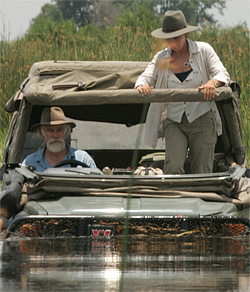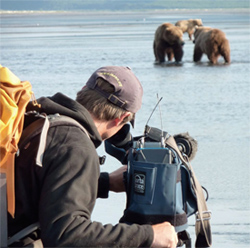Blazing a Path in the Digital Wilderness
BUFFALO, N.Y.
Award-winning wildlife filmmaker Dereck Joubert didn't mean to demonstrate the toughness of tapeless cameras when he swamped his new camera-laden Land Rover in the croc-filled Okavango River in Botswana recently.
"We opened up all our flooded film boxes: a Panasonic 3000, a Varicam, a new Phantom Gold camera, extra lenses, batteries, P2 cards, sound gear, Canon [SLR] cameras and lenses—more than $750,000 worth of gear—drowned! One by one I swam them to shore and laid them out to dry."
After a few days Joubert feared the worst. "Amazingly, all of the cameras and lenses were functional again," he said. "Even the Phantom Cine Mags [hard drives] and the soggy P2 cards worked fine once dried. Tape or film would have been utterly ruined." Most importantly, Joubert was able to continue filming lions without further delay.

Wildlife filmmaker Dereck Joubert recently found out how tough his tapeless gear was when he swamped his Land Rover into Okavango River. For an expedition to Papua, New Guinea, Eric Liner, cinematographer for the Cornell Lab Of Ornithology, chose Convergent Design's solid state Nano Flash to use with their HDW 730 HDCAMs.
"This was a unique opportunity to film some of the world's rarest, birds of paradise so we needed reliable cameras to capture the highest quality feasible in the soggy Guinean rainforest," Liner said. "By recording to Nano Flash, we could capture full raster HD at up to 280 Mbps. on solid state versus tape. After the daily rains, the 730 often flashed humidity warnings, but luckily the camera head was OK so I could feed a clean HD signal to the Nano via HDSDI."
The frequent humidity problems made Liner stop recording HDCAM backups with the Nano, which never failed. This enabled him to leave many boxes of HDCAM tapes behind. "Quality-wise, even the 100 Mbps long GOP MPEG was indistinguishable from HDCAM," he said.
SOFTWARE INTENSIVE
Neverthless, heavy reliance on file-based video often conjures up nightmares of drives crashing and precious footage vaporizing. When he first downloaded Phantom footage, Joubert was startled to find many shots he'd selected missing. "At first I blamed our post supervisor, but later we discovered that by default, the Phantom software self-selected which shots to download, unless disabled. We quickly fixed that problem ourselves," he said.
Naturally, file-based capture is software intensive and not all glitches can be user-corrected as nature filmmaker Joe Pontecarvo learned when first shooting with XDCAM HD.
"I found that you can't mix frame rates on an XDCAM disc like you can with CF cards, tape," he said. "The workaround is to use separate discs for each frame rate. You can mix 720/30p and 1080/30p on a single disc, but not 1080/24p and 30p. I'm hoping Sony fixes that in a firmware upgrade soon."
The ease of overcranking for slow-motion with film prompted many wildlife shooters to hang onto their film cameras until video cameras caught up. Until recently, only a few video cameras could overcrank in HD, notably the original [tape] Varicam, but only in 720p. File-based capture changed that, breaking the 60 fps barrier and the 1080p resolution benchmark. Joubert started with the tape-based Varicam but mainly uses Panasonic's HPX3000 and the Phantom Gold, both file-based.
"The Phantom Gold is fantastic for slow motion but it works at 24 fps as well as at 1000 so I use it at normal speeds too," Joubert said. "Now I have two Cinemags—a 125 and a 256 GB—which holds up to 2 hours of normal speed footage. That used to take me 8 hours to download, but now with a Cinestation, it's much faster."
The file-based Red One has not only raised the quality bar much higher, but kept it affordable and accessible.
"With Red One I can shoot a 4K project at 24 fps or at 23.98, 25, 29.97, 30, 50, 59.94 or 60 fps," said wildlife photographer turned videographer Kennan Ward. "In 3K it goes up to 75 fps and jumps to 120 fps in 2K! I rarely film HD as even clients who want a final in HD 1080 ask for it larger, especially for wildlife. So, I always shoot at the highest rez possible."
Ward downloads his 320 GB Red drives to portable drives in the field when 70 percent full, then backs them up again at his docking station before shipping any footage to Mammoth HD or other stock libraries. "Redundancy, redundancy" is his mantra.
DP Steve Gibby, an early Red One owner also concurs that bigger is generally better.
"Most wildlife shooters use 4K and 3K for the big screen and also for 1080 [TV] finishes," Gibby said. "It has film's depth of field and chromatic richness which persists when resampled and scaled down to 2K or even 1080p," he said. "The ability to capture at 4K, 3K, and 2K with a range of great lenses gives wildlife crews plenty of great new options today."

Joseph PontecorvoTHE DREADED NIGHTMARE
In the wilderness though, nature often determines which technologies to choose. On his next project, the Panasonic HPX3000 will be Joubert's main camera as he'll be mostly on foot and will rely on a small solar charger to charge camera batteries. He won't have the juice necessary to download P2 cards to FireWire drives or CineMags to the CineStation "It will be like shooting film again. I bought a stack of 64 gig P2 cards which I'll use like film rolls. When they're all full, the shoot will be over."
After trying various tape and file-based systems, independent videographer Joe Pontecorvo chose the Sony PDW700 camera for his current wildlife docs on wolverines and bears.
"I've worked a little with P2 and quite a lot with XDCAM EX," Pontecorvo said. "Both were card based with a pretty intensive workflow if you're in the wilderness working off solar power. I was also concerned about safely backing up my media [in the field] and wanted to shoot 4:2:2 @50 Mbps versus 32 Mbps. The XDCAM HD discs are cheap enough to archive to so there is no need to download them in the field."
Every wildlife filmmaker's dread of losing rare footage in the digital wilderness becomes a real world nightmare in the file-based (capture) realm. Stacy Douglass, staff editor for WNET, Nature, urges all Nature cinematographers to backup their footage before shipping it to WNET.
"As an assistant editor we had a drive failure and I spent a long weekend in the studio, redigitizing a season's worth of tapes," she said. "The thought of losing all that footage was terrifying, but luckily we had the original tapes for backup. With file-based media, often that isn't the case as the camera originally only survives on hard drives which may only last a few years. You need to keep updating your backups. Personally, I like the file-based workflow, despite all its challenges."
Get the TV Tech Newsletter
The professional video industry's #1 source for news, trends and product and tech information. Sign up below.
